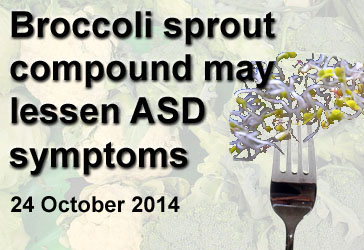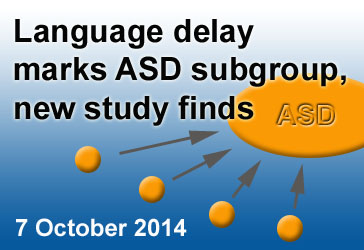Archives
October, 2014
Select a different month in the archive
Chemical in Broccoli Sprouts May Inform ASD Treatment
By Chelsea E. Toledo, M.A. on October 24, 2014

Background: No approved pharmacological treatment exists for the core symptoms of Autism Spectrum Disorder (ASD), which include impaired communication, difficulties with social interaction, and repetitive behaviors. However, some naturally occurring chemicals have been shown to address biochemical irregularities – such as oxidative stress – that are associated with ASD.
What’s new: On October 13, the Proceedings of the National Academy of Sciences published a double-blind study investigating the potential of sulforaphane – a chemical present in vegetables like broccoli sprouts, kale, and bok choy – to ameliorate autism symptoms. The researchers gave sulforaphane supplements extracted from broccoli sprouts to 29 young men between the ages of 13 and 27 over a period of 18 weeks, and compared them to a group of 15 men receiving a placebo. After 18 weeks, the group receiving sulforaphane showed significant improvement in their scores on three different behavioral assessments administered by caregivers and physicians, while the control group experienced little change. The researchers then stopped treatment and continued to observe both groups for four additional weeks, noting that their scores returned to the baselines established before treatment began.
Why it’s important: While many clinical studies aim to control ASD-related behaviors directly, this study addressed the suspected underlying biochemical abnormalities instead. Future studies could delve deeper into the possible benefits of sulforaphane – for instance, whether it can provide early treatment for young children with ASD diagnoses or if it might prevent ASD when taken as a prenatal supplement.
Help me understand :
| Source(s) : |
| Tweet |
New Hypothesis of ASD as a Disorder of Prediction
By Chelsea E. Toledo, M.A. on October 17, 2014

Background: Autism spectrum disorder (ASD) is characterized by difficulties with social communication and tendencies to engage in restrictive, repetitive behaviors. While those traits have been widely recognized, research has yet to determine whether they share a common, underlying cause.
What’s New: On October 6, the Proceedings of the National Academy of Sciences published a study describing a new hypothesis: that ASD symptoms stem from an inability to predict what’s coming next. The researchers suggested that people with the disorder experience events “as if by magic”—with the cognitive systems for linking one happening in their environment to another somehow compromised. While their hypothesis doesn’t explain every aspect of the autism profile, the researchers asserted their belief that predictive impairment underlay two of the most salient and seemingly disparate traits: difficulties with social communication and tendencies to engage in restrictive, repetitive behaviors. For example, the same predictive impairment that inspires an individual to line up objects for comfort could also be at play when that individual experiences difficulty understanding intention of others. Finally, a reduction in motor anticipation could lead to atypical gesture and posture often observed in ASD children.
Why it’s important: This study provides a theoretical framework to explain various features of ASD. With this approach, researchers might be able to identify structures in the brain with differences ascribed to impaired predictive abilities.
Help me understand :
| Source(s) : |
| Tweet |
ASD Subgroup Linked to Brain Volume
By Shana R. Spindler, PhD on October 7, 2014

Background: Autism Spectrum Disorder (ASD) features a diverse set of social and behavioral deficits, language abilities, and skill sets. Identifying unique subgroups in the ASD population is a major goal within the autism research community. Given that individuals within a subgroup may share causal risk factors, a subgroup diagnosis could enable targeted therapy options.
What’s new: Researchers in the United Kingdom have identified a subgroup of ASD based on language delay in childhood. The team used a technique called voxel-based morphometry to measure brain volumes in 80 adult men with ASD. Of the participants, 38 experienced childhood language delay with 42 reporting normal language development. Individuals with delayed language had an overall larger volume of brain grey matter than those with typical language histories. When the team measured specific brain areas, they found several clusters of decreased volume in those with language delay.
Why it’s important: Last year, the Diagnostic and Statistical Manual of Mental Disorders-Fifth Edition (DSM-5) grouped anyone along the autism spectrum into a single diagnosis of ASD. This study highlights the need to assess individual traits within individuals on the spectrum as we work towards understanding the underlying biology of ASD subgroups.
Help me understand :
| Source(s) : |
| Tweet |

